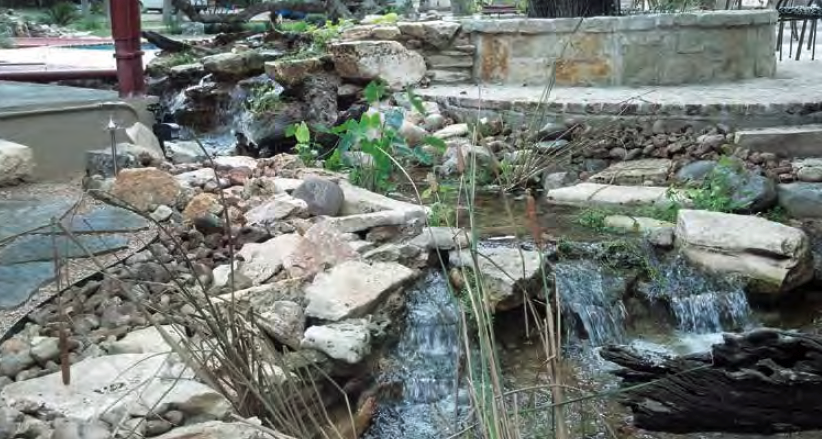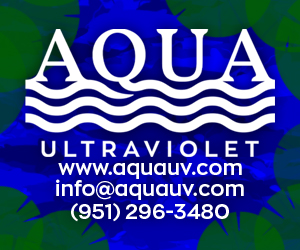
When it comes to ponds, few questions are more common and complicated to answer than “How big should you build?” The potential answers to this daunting question can be endless, depending on what, who, why, where and how. How you approach it can separate the novice or DIY-er from the experienced professional.
As professionals, we are tasked to build the perfect feature. However, “perfect,” in this case, is always defined by the client, so it’s important to be a great listener. It is said that great listeners answer questions with another question to get better clarity of the person, the situation and the anticipated answer.
So, while I cannot come right out and tell you how big you should build, if you were to participate in a game of 20 Questions with Water Garden Gems, I could tell you what you need to know. We are called on as experts to know how big a particular pond or feature should be, but we must humbly understand first and foremost that the customer is the keeper of the answer. Our job is to help them find it.
When a homeowner asks me how big their water feature should be, I always have some basic questions ready to ask. Why do they want the pond? Are they putting koi or goldfish in the pond? What about plants? How often do they plan on enjoying the pond? What drew them to wanting a pond in the first place? What other, if any, landscaping changes or builds are they planning in the near future? Who will end up enjoying the pond? How likely is it that they will want a bigger, better pond in the future after they reap the initial benefits of the pond lifestyle? With the answers to questions like these, we are ready to get somewhere!For it is impossible for a professional to build a client’s “perfection” if they do not know the client and fully understand what they are envisioning.

We were blessed to do a pond rebuild for a wonderful couple this summer. They met with multiple contractors and ultimately chose us to do the job, in large part because I stood in their backyard with them for more than 90 minutes talking, asking questions, throwing ideas at them and, most importantly, listening. My competitors had pitched a project that was double the size they were interested in and three times the budget they had discussed over the phone. They insisted on selling them all new equipment, even though the client’s existing skimmer and water-fall box were perfectly fine to use again in the rebuild. Basically, the contractors did not listen to what the clients wanted, and they were unable to offer an acceptable product. You build to fulfill your client’s needs. This is why they are hiring you.
Be the Expert
After you accept that the client is in control of the answers to all these questions, you can then merge your education, experience and know-how with the client’s desires to create boundaries and basic rules for the project. For example, we cannot build a 500-gallon koi pond — that’s just too small. If the maximum size of the project is 500 gallons, help the customer adjust their expectations. Perhaps shubunkin or sarassa comet gold-fish would be a better option.

If the customer wants koi, how many? The answer to this question sets the floor for minimum size requirements for the pond. What if the customer wants a waterfall to drown out highway noise? With our experience and understanding of water sounds, we know that we have to flow a certain amount of water and drop it through the air from a certain minimum height to create the desired volume of sound for the customer.
There’s also the allotted space to consider, or the blank canvas. You want to help the client envision the project in the space. How will it merge with the landscaping and fit perfectly into place? We do not want to build too small and lose the opportunity to achieve the wow effect that water features tend to bring, but we do not want to build too large and overshadow everything else around it. Horizontal and vertical balance in the landscaping is critical. The water feature must fall into scale within the total landscape, both in space covered and height created.
Ultimately, it is our responsibility to explain how and why we are merging the customer’s dream with our expertise in defining size requirements based on the setting and purpose of use. This is what sets us experienced professionals apart from the rest. We know a koi pond needs to be large. We know a waterfall needs to have some white water, which often requires a larger pump than one might expect. We know that added depth to a pond can make everything easier in the long run with cooler water. We know that shallow beach slopes, while they look neat, are feeding grounds for predator birds and raccoons and should not be part of a koi pond.
Know Your Customer

Remember that the definition of perfection in this situation is twofold. It is defined by the homeowner in visual and blending effects and defined by the contractor from a purpose and use angle. It has to be big enough for the client to use properly for their personal desires, whether it be a water feature in the landscaping or a koi pond feeding their upcoming hobby. It must be sized perfectly into its space within the environment so that it visually fits.
So, how big should you build? Build the size that looks right to the customer within the space constraints and landscaping. The customer is a huge part of this part of the equation. Always build the size so that the utilitarian purpose of the feature is achieved. Base the size the customer needs on the 20 questions you ask at the consultation.
The perfect size of a feature is not dimensional; it is defined by what, who, where, why and how. It takes a professional to be able to answer these questions.


